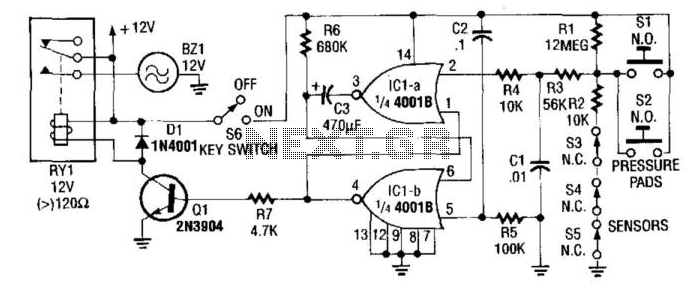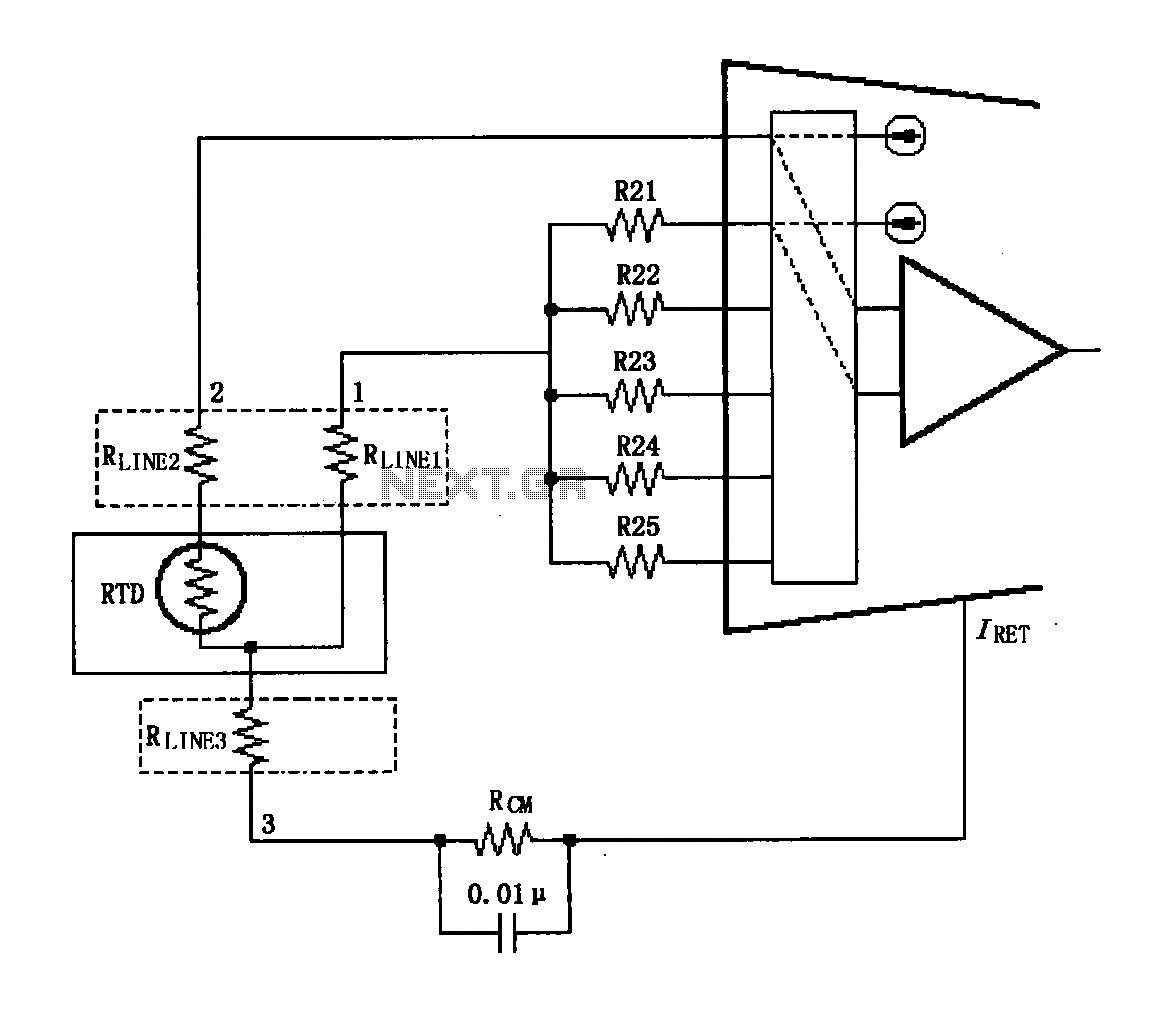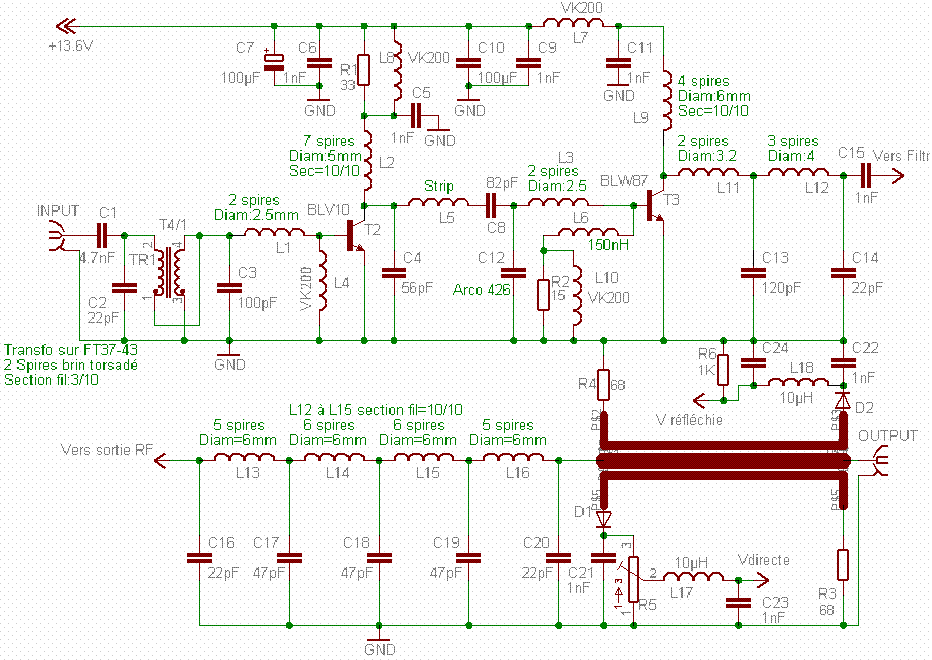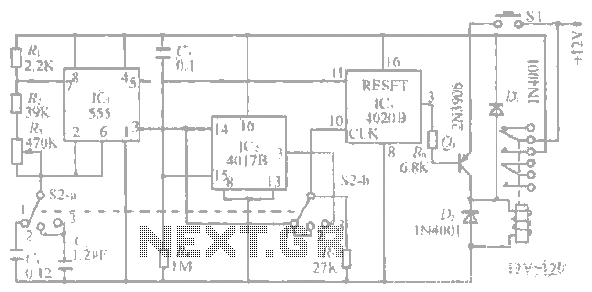
Latest Wireless Car Alarm circuit diagram and explanation
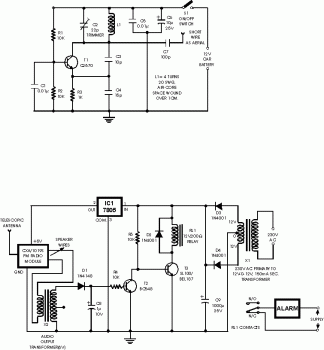
This circuit is a wireless car alarm system composed of two modules: a transmitter and a receiver. It operates using FM radio waves and is compatible with vehicles that have a 6-12V DC power supply. If the vehicle's power supply exceeds this range (e.g., 24V), a voltage stabilizer can be employed. The mini VHF FM transmitter is installed in the vehicle when parked. The receiver unit utilizes the CXA1019, a single IC-based FM radio module readily available in the market. The receiver is tuned to the transmitter's frequency. When the transmitter is active and signals are received, no hissing noise is heard at the output of the receiver, causing transistor T2 (BC548) to remain non-conductive. This allows the relay driver transistor T3 to receive forward base bias through a 10k resistor (R5), energizing the relay. If an intruder attempts to drive the car away, the radio link between the transmitter and receiver is disrupted, resulting in the FM radio module generating hissing noise. These hissing AC signals are coupled to the relay switching circuit via an audio transformer. The signals are then rectified and filtered by diode D1 and capacitor C8, producing a positive DC voltage that biases transistor T2. Consequently, transistor T2 conducts, grounding the base of relay driver transistor T3, which deactivates the relay and activates the alarm connected through the normally closed (N/C) contacts of the relay. Even if the intruder disconnects the transmitter from the battery, the remote alarm remains active, as the receiver continues to emit hissing noise in the absence of a signal. This design ensures the burglar alarm is fool-proof and highly reliable.
This wireless car alarm system is designed for effective security by utilizing FM radio technology to establish a communication link between the transmitter and receiver modules. The transmitter, typically housed within the vehicle, emits radio waves that are tuned to a specific frequency corresponding to the receiver. The CXA1019 module, known for its simplicity and availability, serves as the core component of the receiver, which is responsible for detecting the transmitted signals.
The operational mechanism begins with the transmitter being active while the vehicle is parked. Under normal conditions, the receiver detects these signals without producing any audible noise, allowing the system to remain inactive. The transistor T2 plays a crucial role in this state, as it remains off, preventing any unintended activation of the relay driver transistor T3. The relay, which is integral to the alarm system, remains de-energized, ensuring that the alarm is silent and the vehicle is secure.
In the event of a security breach, such as an unauthorized attempt to move the vehicle, the disruption of the radio link triggers a change in the receiver's output. The generation of hissing noise signifies that the connection has been compromised. This noise is effectively coupled through an audio transformer to the relay switching circuit, where it undergoes rectification and filtering. The diode D1 ensures that only positive voltage is allowed to pass, while capacitor C8 smooths out any fluctuations in the voltage.
Once the positive DC voltage is established, it provides the necessary forward bias to transistor T2, turning it on. This action pulls the base of transistor T3 to ground, effectively deactivating the relay and triggering the alarm system. The use of normally closed contacts in the relay ensures that the alarm is activated in response to the loss of the signal, providing an additional layer of security.
The system is designed to remain operational even if the transmitter is disconnected from its power source, as the receiver continues to generate hissing noise. This feature effectively prevents the intruder from disabling the alarm system by simply cutting power to the transmitter, thereby enhancing the overall reliability of the alarm system.
Overall, this wireless car alarm system presents a robust solution for vehicle security, combining simplicity in design with effective performance to deter potential theft or unauthorized access.This circuit is a wireless car alarm system that is built using two circuit modules, namely modules of transmitter and receiver modules. This circuit works on FM radio waves. Car alarms can be used on vehicles that have a 6-12VDC power supply. You can use the voltage stabilizer if your car power supply is too large (eg 24V). The mini VHF, FM tran smitter is fitted in the vehicle at night when the car is parked in the car porch. The receiver unit is built with CXA1019. CXA1019 a single IC-based FM radio module which is freely available in the market, is kept inside. Receiver is tuned to the transmitter`s frequency. When the transmitter is on and the signals are being received by FM radio receiver, no hissing noise is available at the output of receiver. Thus transistor T2 (BC548) does not conduct. This results in the relay driver transistor T3 getting its forward base bias via 10k resistor R5 and the relay gets energised.
When an intruder tries to drive the car and takes it a few metres away from the car porch, the radio link between the car (transmitter) and alarm (receiver) is broken. As a result FM radio module will generate hissing noise. Hissing AC signals are coupled to relay switching circuit via audio transformer. These AC signals are rectified and filtered by diode D1 and capacitor C8, and the resulting positive DC voltage provides a forward bias to transistor T2.
Thus transistor T2 conducts, and it pulls the base of relay driver transistor T3 to ground level. The relay thus gets de-activated and the alarm connected via N/C contacts of relay is switched on. If the intruder finds out about the wireless alarm (which already turned on) and disconnects the transmitter from battery, still remote alarm remains activated. It will not turn off the alarm because in the absence of signal, the receiver continues to produce hissing noise at its output.
So the burglar alarm is fool-proof and highly reliable. 🔗 External reference
This wireless car alarm system is designed for effective security by utilizing FM radio technology to establish a communication link between the transmitter and receiver modules. The transmitter, typically housed within the vehicle, emits radio waves that are tuned to a specific frequency corresponding to the receiver. The CXA1019 module, known for its simplicity and availability, serves as the core component of the receiver, which is responsible for detecting the transmitted signals.
The operational mechanism begins with the transmitter being active while the vehicle is parked. Under normal conditions, the receiver detects these signals without producing any audible noise, allowing the system to remain inactive. The transistor T2 plays a crucial role in this state, as it remains off, preventing any unintended activation of the relay driver transistor T3. The relay, which is integral to the alarm system, remains de-energized, ensuring that the alarm is silent and the vehicle is secure.
In the event of a security breach, such as an unauthorized attempt to move the vehicle, the disruption of the radio link triggers a change in the receiver's output. The generation of hissing noise signifies that the connection has been compromised. This noise is effectively coupled through an audio transformer to the relay switching circuit, where it undergoes rectification and filtering. The diode D1 ensures that only positive voltage is allowed to pass, while capacitor C8 smooths out any fluctuations in the voltage.
Once the positive DC voltage is established, it provides the necessary forward bias to transistor T2, turning it on. This action pulls the base of transistor T3 to ground, effectively deactivating the relay and triggering the alarm system. The use of normally closed contacts in the relay ensures that the alarm is activated in response to the loss of the signal, providing an additional layer of security.
The system is designed to remain operational even if the transmitter is disconnected from its power source, as the receiver continues to generate hissing noise. This feature effectively prevents the intruder from disabling the alarm system by simply cutting power to the transmitter, thereby enhancing the overall reliability of the alarm system.
Overall, this wireless car alarm system presents a robust solution for vehicle security, combining simplicity in design with effective performance to deter potential theft or unauthorized access.This circuit is a wireless car alarm system that is built using two circuit modules, namely modules of transmitter and receiver modules. This circuit works on FM radio waves. Car alarms can be used on vehicles that have a 6-12VDC power supply. You can use the voltage stabilizer if your car power supply is too large (eg 24V). The mini VHF, FM tran smitter is fitted in the vehicle at night when the car is parked in the car porch. The receiver unit is built with CXA1019. CXA1019 a single IC-based FM radio module which is freely available in the market, is kept inside. Receiver is tuned to the transmitter`s frequency. When the transmitter is on and the signals are being received by FM radio receiver, no hissing noise is available at the output of receiver. Thus transistor T2 (BC548) does not conduct. This results in the relay driver transistor T3 getting its forward base bias via 10k resistor R5 and the relay gets energised.
When an intruder tries to drive the car and takes it a few metres away from the car porch, the radio link between the car (transmitter) and alarm (receiver) is broken. As a result FM radio module will generate hissing noise. Hissing AC signals are coupled to relay switching circuit via audio transformer. These AC signals are rectified and filtered by diode D1 and capacitor C8, and the resulting positive DC voltage provides a forward bias to transistor T2.
Thus transistor T2 conducts, and it pulls the base of relay driver transistor T3 to ground level. The relay thus gets de-activated and the alarm connected via N/C contacts of relay is switched on. If the intruder finds out about the wireless alarm (which already turned on) and disconnects the transmitter from battery, still remote alarm remains activated. It will not turn off the alarm because in the absence of signal, the receiver continues to produce hissing noise at its output.
So the burglar alarm is fool-proof and highly reliable. 🔗 External reference
